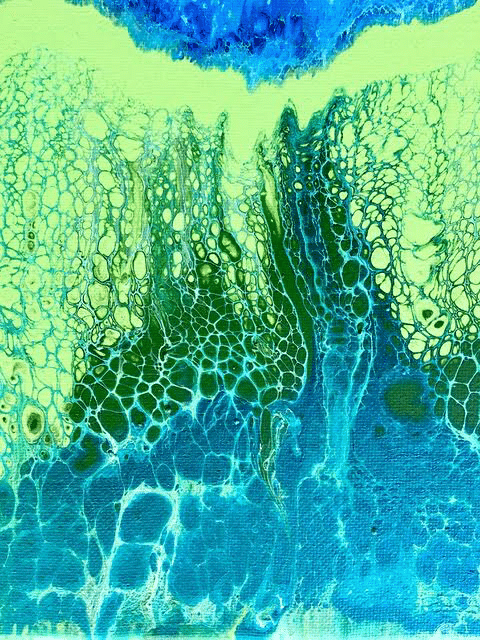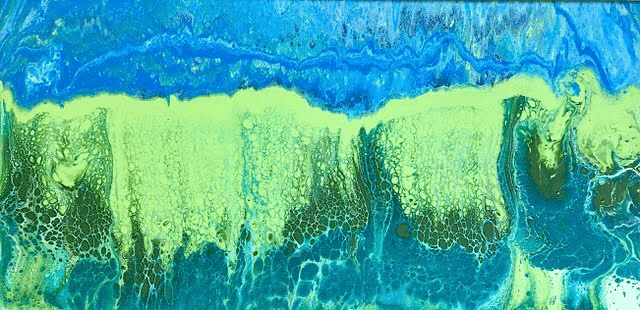As artists (and people) we are always on a journey. Something will capture our interest and inspire us to want to learn more. Whatever it may be—drawing, painting, sculpting, pouring—that new thing becomes the focus of our attention. We may spend weeks, months, or even decades exploring whatever it is that has captured our fancy. Eventually (but not always) we either master the art form and move on, lose interest in the art form and move on, or the art form simply leads us to the next inspiring thing.
I discovered acrylic pour painting about two years ago and I was smitten. Up until then I had been creating some beautiful hanging sculptures made from found natural objects that I called The Mountain House Series.
Once I discovered how to make my own flip cup pour, I put that series on hold. I had found a new muse and wanted to explore all the exciting, new pouring possibilities. Just a few weeks into my pouring journey I remember thinking “I wonder where this is going to lead? Can an artist continue doing flip cups and swipes forever?” Now, two years later I’m starting to find some answers to those questions.
I still love flip cup pours and swiping (and continue making them because they are so much fun) but I have started pushing myself to explore pouring on a deeper level. I want to discover ways to capture the unpredictable beauty of a pour painting and use it to create something other than a totally abstract poured image. Using a bit of hindsight I see that I have been looking for wonderful side trips all along. Remember the videos “Poinsettia Pour”, “Starting the Summer With Acrylic Waves” and the video “Free Style vs. Flip Cup” that dipped a toe into the pool of free-style pouring? Those videos were my way of exploring the possibilities of pour painting.
What I really want to explore now is how to use acrylic pouring techniques to create paintings that retain the beautiful unpredictability of a pour, but at the same time are recognizable as a landscape. So many of the pour paintings we make already remind me of a landscape because of the horizontal lines that stretch across the canvas. In these pouring experiments, I want to be more intentional and pour with a purpose. My goal is to find a way to create an image that is undeniably a landscape but is made unique and beautiful because of the pour painting magic that we all love.


This video is the first of several that I plan to create, sharing with you my journey down this new road of Abstract Poured Landscapes. I hope you enjoy the video and find a few tricks that you can use in your own pours. I also hope that you can learn from my mistakes and can save some time (and paint) by figuring out what not to do. I’m not sure where this road will lead but I have a really good feeling about it and that’s half the fun. I hope you enjoy the video.
Frequently Asked Questions About Acrylic Pouring Landscape Series
1. Can acrylic pouring be used to create landscapes?
Yes, acrylic pouring can be manipulated to create beautiful and abstract landscape artworks.
2. Do I need special colors to create landscapes?
While no special colors are required, choosing colors that represent natural elements like green for trees and blue for skies can be helpful.
3. Can I add details to my landscape after pouring?
Absolutely, using brushes or other tools to add details after the pour is completely dry is common.
4. Is creating landscapes with acrylic pouring suitable for beginners?
Yes, it may involve some learning and experimentation but is suitable for all levels.
5. Can I use texture mediums to create more realistic landscapes?
Yes, texture mediums can be used to create elements like mountains or trees with more realism.
6. How long do landscape pours take to dry?
It typically takes between 24 to 72 hours, depending on the thickness and environmental conditions.
7. Can I mix painting techniques, like brush painting and pouring in one landscape artwork?
Certainly, mixing techniques can yield unique results and add depth to the landscape.
What to Read Next…
Creating Resin Pours Inspired by Nature

Steve Shaw is an artist and teacher living in Atlanta, Georgia. His days are spent in the classroom teaching his students the basics of art and self-expression. In the evenings and weekends, he paints. Steve has shown his work in several galleries in the Southeast and has illustrated three children’s books. Recently Steve has discovered acrylic pour painting and is putting all his other projects on hold while he journeys down this artistic road.
To see more, follow him on Instagram, visit his website, watch his videos on his YouTube Channel and purchase his paintings at Etsy.com.

I like to do the paint pour landscapes as well. I wait until the paint has set before adding a moon. You can add a sun when its wet which I did once and it did fan out a little but it still looked amazing.
Interesting. What brought me to acrylic pouring, and using resin, was a way I could interpret a particular subject about which I was already making large oil paintings. I wanted to incorporate the abstract and semi-abstract work into the series. I am still working it out, although I feel like I am getting a bit closer to finding what fits for me. I’ll be interested to see where your work takes you.
Love this and would love to showcase my trees that i create by pouring and manipulating paint with palette knives